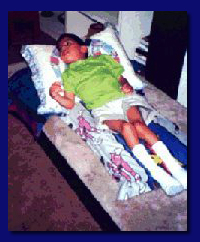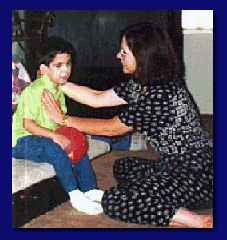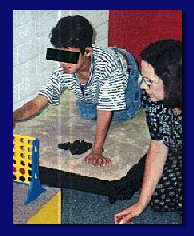Clinical Observation:
AS is 11 years old and has severe scoliosis. With use of the table 2-3 times a day, relaxing and lengthening the muscles of the back with noted improvement in posture and balance has been noted clinically.

A.G. is positioned on The Motion Table
and receives vestibular stimulation
for prolonged periods.
nne foster and adoptive family home considers the Motion Table an invaluable asset when providing care to children placed in the home. It is used at varying speeds and with the individuals in different positions. Positioning is accomplished with sidelyers, molded seats, wedges, and other positional aids. It has proven to be helpful, especially when caring for children with respiratory conditions. It assists with coughing, deep breathing, and clearing airways. All the children placed in the home have had a calming benefit and many have stopped self-injurious behavior.KB is a 12 year old boy with medical diagnoses including juvenile onset rheumatoid arthritis, cerebral palsy, and hearing impairment. He is generally very distractible requiring continual redirection to task during structured activity. He has always shown a strong desire to move on to the next piece of therapy equipment or activity during therapy sessions.
He seeks out activities such as the platform swing. When he was first given a session including the Motion Table, he participated for thirty minutes of the treatment involving gross motor and balance activities without attempting to move from the table. After two years experience of treatments with the table, he continues to evidence increasing tending to task during therapy sessions and subsequent classroom activities.
One 5-year-old child with medical diagnoses including cerebral palsy and congenital blindness acquired a table for home use. Initial predictions for functional performance were negative after his birth. Prior to obtaining the table, half his speech therapy sessions were spent calming him, redirecting him to task, and desensitizing tactile defensiveness to allow hand over hand manual signing. When The Motion Table was introduced in the home, the time spent in therapy redirecting and desensitizing was cut significantly. When the table was in the home and he had free access to it, calming time was rarely necessary and took no longer than two to four minutes of the session. When the table was unavailable after several months of use, increasing time was spent redirecting and calming during sessions.

A.G. actively participates in therapy
on the Motion Table
JH is a 12-year old boy who uses The Motion Table daily. When he is using it consistently, he is motivated to follow through with activities and demonstrates increased attention and calmness. When the table is not available, increased aggression is noted. At home, he could become a danger to his younger sister.
TS is a child placed in foster care in 1991. Her medical diagnoses include spastic quadriplegia secondary to cerebral palsy, marked scoliosis, seizure disorder, hip dislocation, blindness, and severe behavioral problems. She screamed for 16-18 hours a day despite efforts to calm her. Two years after placement in the home, she acquired a table for home use and sleeps on it for 4-5 hours at a time. When she awakens, she turns the table on and returns to sleep. With the decrease in screaming and behavioral problems, she is more alert and aware of the activities around her. Her foster mother reports behaviors and screaming have decreased almost 80%.
MS is a 13-year old female who is profoundly mentally retarded and has cerebral palsy and a tracheostomy. Prior to the use of the table, she required breathing treatments every 4-6 hours. As a result of using the table, percussion is no longer necessary while administering the breathing treatments. Rather, she is positioned on the table for 10-15 minutes. Since using the table her breathing treatments are less frequent and there have been less respiratory infections. Use of the table also relaxes her and helps her align her body which helps her to breathe deeper and easier. She becomes congested less frequently.
BR is a 19-year old male who experienced severe neurological deficits secondary to a closed head injury sustained in a motor vehicle accident at 15 years old. He acquired a wheelchair model Motion Table for home use two years after his injury. Before obtaining his table, he kept his head rotated to the left and flexed toward his shoulder each time he was positioned in his chair. Though he has a J-Tube, it has been used primarily for fluids and medications. His primary source of nutrition was feeding by mouth. Feeding had become progressively difficult and choking was common, even on pudding. Within a few days of using the table 3-4 hours a day dramatic improvement was noted. He had become much more alert and focused. He often turns his head fully to the right and maintains the position for several minutes. He has been able to activate his communication device with this movement. He has been able to complete his meals without choking or fatiguing. Meals have become much less stressful for BR and his mother without the fear of aspiration.
Individuals can assume a variety
of positions while performing
activities on the Motion Table

DE has strong extensor tone and is very anxious in response to minimal stimulation. Positioning and transfers were frequently unsafe. Range of motion exercising was not possible predisposing him to contractures. Oral feedings were difficult secondary to his extensor tone. He was unable to relax on his own for more than five seconds. Now he is using The Motion Table, he is able to cooperate with range of motion exercises, is showing progress in developing gross and fine motor skills, and is relaxed for safe positioning and transfers.
MR is a 2-year old male who experienced a brain injury at 9 months old as the result of a hypoxic episode. During physical therapy treatments, he required self-calming periods lasting 5-10 minutes each 20 minutes of the sessions. Since treatment on The Motion Table has been initiated, dramatic improvement is noted. He tolerates a full 60-minute session with only a few short periods of self-calming. He has experienced a substantial increase in motor skills and has begun visually exploring his environment. He has experienced a decrease in reflux when The Motion Table is used for 20 minutes prior to his tube feedings.
MY was born 3 weeks early and experienced classic symptoms of poor internal regulation and an immature nervous system. He was not sucking well, not sleeping well, not gaining weight well, and was very irritable. At the time he received his crib model Motion Table for home use at 7 weeks old, he was nursing better and gaining weight but still was not sleeping well and was very irritable. His naps were only 20 minutes at a time. Use of The Motion Table served to calm him when irritable and to help him sleep longer once asleep. He would calm within a few minutes of being placed in The Motion Table and would stay asleep for more than an hour. He used The Motion Table until he was 5 and one half months old.
JB, a child with cerebral palsy and a history of chronic constipation, has evidenced positive responses to use of her Motion Table. Her tone reduced significantly within a few minutes of her initial trial use. A home model was requested to increase peristalsis and decrease chronic constipation.
NS is a three-year old child with a diagnosis of athetiod cerebral palsy. She has experienced chronic constipation requiring manual assistance for bowel movements since she was two years old. She experienced a positive change in her bowel habits upon using a Motion Table at home. When she spends a weekend with her father, her non-custodial parent, she again becomes constipated.
Participants of a children’s day care center geared toward special needs clients have also experienced positive clinical changes. Using The Motion Table at the center in conjunction with sensory input from other sources, has evidenced progress to the extent families of participants are pursuing funding sources to purchase Motion Tables for home use. Gains in concentration levels, communication skills, and positive interactions with others have been observed. In addition, decrease in self-stimulating behavior, self-injurious behavior, aggressive/assaultive behavior, loud inappropriate vocalizations, and property damage has been noted.